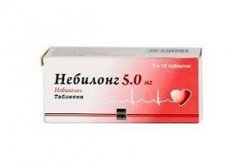Medical expert of the article
New publications
Preparations
Nebilong
Last reviewed: 03.07.2025

All iLive content is medically reviewed or fact checked to ensure as much factual accuracy as possible.
We have strict sourcing guidelines and only link to reputable media sites, academic research institutions and, whenever possible, medically peer reviewed studies. Note that the numbers in parentheses ([1], [2], etc.) are clickable links to these studies.
If you feel that any of our content is inaccurate, out-of-date, or otherwise questionable, please select it and press Ctrl + Enter.

Nebilong has antianginal, antiarrhythmic and antihypertensive properties.
Indications Nebilonga
It is used to lower high blood pressure, prevent the development of attacks of coronary heart disease or angina pectoris, and also in the complex therapy of CHF.
Release form
The drug is released in tablets of 2.5, 5 and 10 mg, packaged in blister packs. Inside the pack there are 15, 50 or 105 tablets.
Pharmacodynamics
The drug is a cardioselective β1-adrenergic blocker that has a vasodilatory effect. It blocks the activity of β1-adrenergic receptors and transforms the processes of production of the endothelial relaxing factor. A decrease in blood pressure is associated with a decrease in the values of total peripheral vascular resistance, circulating blood volume, and cardiac output, as well as with a slowdown in the processes of renin formation and a weakening of the sensitivity of baroreceptors.
Often, the antihypertensive effect of Nebilong manifests itself after 7-14 days, and normalization of values occurs within 1 month.
The drug reduces heart rate during rest and exercise, reduces the heart muscle's need for oxygen, and in addition improves the level of diastolic filling, reduces the weight of the myocardium with its mass index and has a positive effect on the daily rhythm of blood pressure values.
The drug does not affect the process of lipid metabolism.
Pharmacokinetics
Dosing and administration
The medication should be taken orally, in a dose of 2.5-5 mg per day (in the morning). If the indications require it, the dosage can be increased to 10 mg per day.
Elderly people should initially take 2.5 mg per day, and if necessary, increase this dose to 5 mg of the substance.
 [ 11 ]
[ 11 ]
Use Nebilonga during pregnancy
The use of the medication during pregnancy is permitted only if there are strict medical indications, because there is a very high probability that it will cause bradycardia, hypoglycemia and respiratory paralysis in the newborn, as well as a decrease in blood pressure.
The use of the drug should be discontinued 2-3 days before the expected day of birth. If this is not possible, or if premature birth occurs, the baby's condition should be closely monitored during the first 3 days of life.
Contraindications
Among the contraindications:
- presence of severe sensitivity to the drug;
- untreated pheochromocytoma;
- presence of asthma;
- liver pathologies;
- in the decompensation phase of CHF;
- cardiogenic shock;
- angina pectoris of angiospastic nature;
- decreased blood pressure;
- state of depression;
- myasthenia or bradycardia.
 [ 8 ]
[ 8 ]
Side effects Nebilonga
The use of the drug may cause the occurrence of certain side effects:
- headaches, feeling sleepy or tired, and dizziness;
- depression, insomnia, paresthesia, impaired concentration and hallucinations;
- constipation or diarrhea, dry mouth and nausea;
- edema, orthostatic collapse, arrhythmia, cardialgia, bradycardia, bronchial spasms and dyspnea;
- runny nose, hyperhidrosis, local allergy symptoms and photodermatosis.
Interactions with other drugs
Combination of the drug with SG does not cause potentiation of the slowing effect on AV conduction.
When combining the drug with general anesthetic drugs, the risk of lowering blood pressure increases and reflex tachycardia is suppressed.
Concomitant use with cimetidine leads to an increase in blood levels of the drug.
Medicines from the group that suppress the process of OZS also inhibit the metabolic processes of Nebilong.
A decrease in the activity of cimetidine is observed when combined with sympathomimetics.
Tricyclics and barbiturates can potentiate the antihypertensive properties of the drug.
Storage conditions
Nebilong requires maintenance at temperatures of maximum 25°C.
Shelf life
Nebilong can be used within 24 months from the date of manufacture of the medicinal product.
Application for children
Nebilong is not prescribed in pediatrics (up to 18 years of age).
Analogues
Analogues of the drug are Nebivator, Nevotens, Bivotens with Nebivolol, Nebilet, OD-Neb and Binelol with Nebicor Adifarm.
 [ 18 ]
[ 18 ]
Reviews
Nebilong generally receives positive feedback from patients regarding its therapeutic effects.
Doctors believe that the use of drugs allows for the patient's condition to be stabilized fairly quickly. If it is necessary to enhance the drug effect, Nebilong N (a combination of hydrochlorothiazide and nebivolol) or Nebilong AM (a combination of amlodipine and nebivolol) are sometimes prescribed.
Attention!
To simplify the perception of information, this instruction for use of the drug "Nebilong" translated and presented in a special form on the basis of the official instructions for medical use of the drug. Before use read the annotation that came directly to medicines.
Description provided for informational purposes and is not a guide to self-healing. The need for this drug, the purpose of the treatment regimen, methods and dose of the drug is determined solely by the attending physician. Self-medication is dangerous for your health.

